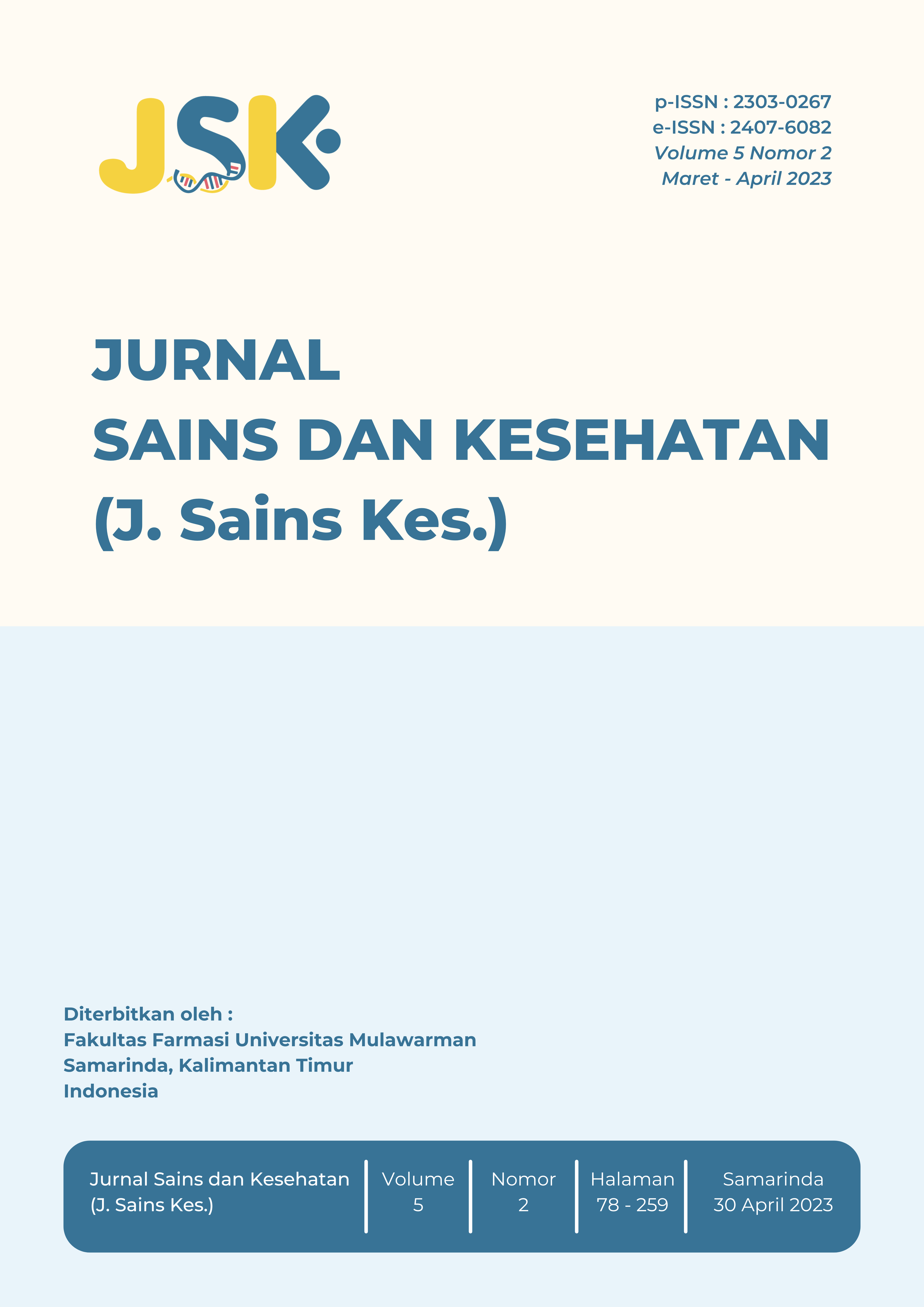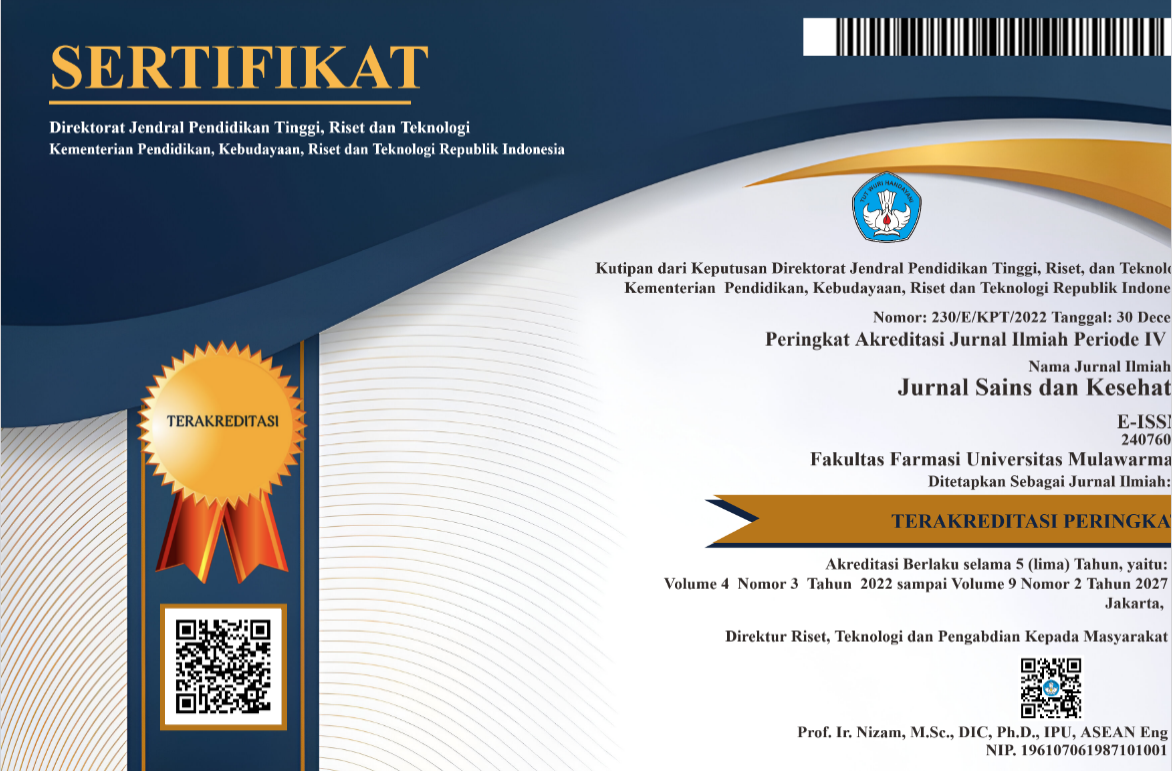In Silico Study of Bajakah Compounds (Spatholobus suberectus) to ProteaseSARS-CoV-2 Inhibitor
DOI:
https://doi.org/10.30872/jsk.v5i2.p78-89Keywords:
SARS-CoV-2, bajakah, molecular docking, licochalcone AAbstract
References
World Health Organization. COVID-19 Public Health Emergency of International Concern (PHEIC) Global research and innovation forum. 2020. Available from: https://www.who.int/publications/m/item/covid-19-public-health-emergency-of-international-concern-(pheic)-global-research-and-innovation-forum [visited on May 09th 2021]
Khaerunnisa, S., Kurniawan, H., Awaluddin, R., Suhartati, S., Soejipto S. Potential Inhibitor of COVID-19 Main Protease (Mpro) from Several Medicinal Plant Compounds by Moleculer Docking Study. Preprints. 2020.
Wink, M., & Mohamed G. Evolution of chemical defense traits in the Leguminosae: mapping of distribution patterns of secondary metabolites on a molecular phylogeny inferred from nucleotide sequences of the rbcL gene [J]. Biochem Syst Ecol. 2003;31(8):897–917.
Huang KC. The pharmacology of Chinese herbs. Boca Rat CRC Press. 1993;261.
Li, RW., Lin, GD., Myers, SP., Leach D. Anti-inflammatory activity of Chinese medicinal vine plants. J Ethnopharmacol. 2003;5:61–7.
Y Goda, M Shibaya, U Sankawa GY. Inhibitors of prostaglandin biosynthesis from Mucuna birdwoodiana. Chem Pharm Bull. 1987;35:2675–7.
Jiang, S.Y., Huang, K., Liu, W., Fu, F.M., Xu J. Combined AutoDock and comparative molecular field analysis study on predicting 5-lipoxygenase inhibitory activity of flavonoids isolated from Spatholobus suberectus Dunn. Zeitschrift Fur Naturforsch C J Biosci. 2015;70(3–4):103–13.
Jain, A.N., Nicolls A. Recommendations for Evaluations of Computational Methods. J Comput Aided Mol. 2008;(22):133–9.
Moitessier, N., Englebienne, P., Lee, D., Lawandi, J., Corbeil C. Towards the Development of Universal, Fast and Highly Accurate Docking Scoring Methods: a Long Way to Go. Br J Pharmacol. 2008;153(1):7–26.
Morris GM, et al. AutoDock Version 4.2: Automated Docking of Flexible Ligands to Flexible Receptors. La Jolla, California, USA Scripps Res Institute. 2009;
Eris Septiana. Prospek Senyawa Bahan Alam Sebagai Antivirus Dalam Menghambat SARS-CoV-2. BioTrends. 2020;11(1):30–8.
Badan Pengawasan Obat dan Makanan Republik Indonesia. Informatorium Obat COVID-19 di Indonesia. BPOM [Internet]. 2020;24. Available from: ISBN 978-602-415-009-9
Kitchen D., Decornez H, Furr J, Bajorath J. Docking and Scoring in Virtual Screening for Drug Discovery. Nat Rev Drug Discov. 2004;48:507–16.
Hawskins P, Warren G, Skillman A, Nicholls A. How to do an Evaluation: Pitfalls and Traps. J Comput Mol Des. 2008;22:179–90.
Rachmania R., Supandi, Cristina F. Analisis Penambatan Molekul Senyawa Flavonoid Buah Mahkota Dewa (Phaleria macrocarpa (Scheff.) Boerl.) pada Reseptor a-Glukosidase sebagai Antidiabetes. Pharmacy. 2016;13:239–51.
Idrees S, Ashfaq U. Discovery and design of cyclic peptides as dengue virus inhibitors through structure- based molecular docking. Asian Pac J Trop Med. 2014;7(7):513–6.
Chen, M., Zhai, L., Christensen, S., Theander, T., and Kinoshita T. Inhibition of fumarate reductase in Leishmenia major and L. Donovani by chalcones. Antimicrob Agents Chemother. 45:2023–9.
Rafi, M., Rosen, R., Vassil, A., Ho, C., Zhang, H., Ghai G et al. Modulation of bel-2 and cytotoxicity by licochalcone-A, a novel estrogenic flavonoid. Anticancer Res. 20:2653–8.
Adianti, M. et al. Anti-hepatitis C virus compounds obtained from Glycyrrhiza uralensis and other Glycyrrhiza species. Microbiol Immunol. 2014;58:180–7.
Toda, S., Shirataki Y. Inhibitory effects of isoflavones on lipid peroxidation by reactive oxygen species. Phytother Res. 1999;13:163–5.
Ding, B., Yuan, L., Yu, H., Li, L., Ma, W., Bi, Y. et al. Genistein and Folic Acid prevent oxidative injury induced by b-amyloid peptide. Basic Clin Pharmacol Toxicol. 2011;108::333–4.
Huang, W.H., Lee, A.R., Yang C. Antioxidative and anti-inflammatory activities of polyhydroxy flavonoids of Scutellaria baicalensis. Biosci Biotechnol Biochem. 2006;(2371):80.
Jung, M. et al. Antioxidant Activity from the Stem Bark of Albizzia julibrissin. Arch Pharm Res. 2003;26(6):458–62.
Tay K-C, Tan LT-H, Chan CK, Hong SL, Chan K-G, Yap WH, et al. Formononetin: A Review of Its Anticancer Potentials and Mechanisms. Front Pharmacol. 2019;10(July):1–19.
Dai, W. et al. Antiviral Efficacy of Flavonoids against Enterovirus 71 Infection in Vitro and in Newborn Mice. Mdpi Journal, Viruses. 2019;625.
Fu, Y.J., Zhu, Y.G.,Wu, N., Kong, Y., Liu, W., Hua X. Application of Cajanus cajan stilbene acid and pinostrobin in Cajanus cajan leaf in preparing anti-herpes virus medicament. 2009;(CN101485649):7–22.
Sun, L., Luo, Q.F., Yang, J., Chen, D.H., Si, J.Y., Pan, R.L. et al. Application of Cajanus cajan L. extracts in preparing hyperlipemia medicine. 2008;CN10120441(18):6–25.
Luo, Q.F., Sun, L., Si, J.Y., Chen D. Hypocholesterolemic effect of stilbenes containing extract-fractionfrom Cajanus cajan L. ondiet- induced hyper cholesterolemia in mice. Phytomedicine. 2008;15:932–9.
Zheng, Y.Y., Yang, J.,Chen, D.H., Sun L. Effects of the stilbene extracts from Cajanus cajan L. On ovariectomy-inducedboneloss in rats. Acta PharmSin. 2007;42:562–5.
Luo, Q.F., Sun, L., Si, J.Y., Chen, D.H., Du G. Hypocholesterolemic effect of stilbene extract from Cajanus cajan L. On serum and hepatic lipid in diet-induced hyperlipidemic mice. Acta Pharm Sin. 2008;43:145–9.
Nwodo, U. et al. In vivo evaluation of the antiviral activity of Cajanus cajan on measles virus. Arch Virol. 2011;156:1551–7.
Chunhakant, S., Chaicharoenpong C. Antityrosinase, Antioxidant, and Cytotoxic Activities of Phytochemical Constituents from Manilkara zapota L. Bark. Molecules. 2019;24:2798.
Umamaheswari, M., Madeswaran, A., and Asokkumar K. Virtual Screening Analysis and In-vitro Xanthine Oxidase Inhibitory Activity of Some Commercially Available Flavonoids. Iran J Pharm Res IJPR. 2013;12(3):317–23.
MacRaild C.A., Daranas A.H., Bronowska A. HS. Global changes in local protein dynamics reduce the entropic cost of carbohydrate binding in the arabinose-binding protein. J Mol Biol. 2007;368:822–32.
Bronowska A.K. Thermodynamics of ligand-protein interactions: Implications for molecular design. In: Moreno-Piraján J.C., editor. Thermodynamics—Interaction Studies—Solids, Liquids and Gases. InTech; Rijeka, Croat. 2011;1–48.
Liu S.Q. et al. Protein folding, binding and energy landscape: A synthesis. In: Kaumaya P.T.P., editor. Protein Engineering. InTech; Rijeka, Croat. 2012;207–252.
Li H., Xie Y., Liu C. LS. Physicochemical bases for protein folding, dynamics, and protein-ligand binding. Sci China Life Sci. 2014;57:287–302.
Lipinski C., Lombardo F, Dominy B., Feeney P. Experimental and computational approaches to estimare solubility and permeability in drug discovery and development settings. Adv Drug Deliv Rev. 2001;46:3–26.
Lipinski C., Lombardo F, Dominy B., Feeney P. Drug Discovery Today. Technologie. 2004;1(4):337–41.
Wulandari EK. Karya Pascasarjana Kimia?: Analisis Interaksi Histone Deacetylase (HDAC) Kelas II Homo Sapiens Dengan Suberoyllanilide Hydroxamic Acids (SAHA) dan Trichostantin A (TSA). 2010.
Weni M, et al. Studi In Vitro dan Penambatan Molekuler Senyawa Bioaktif Ekstrak dan Fraksi Daun Sirih Merah (Piper crocatum) sebagai Inhibitor ?-Glukosidase. Bogor (ID); 2018.
Stegemann, S. et al. When poor solubility becomes an issue: From early stage to proof of concept. Pharm Sci. 2007;31:249–61.
O’Hagan, S.and Kell D. The Apparent Permeabilities of Caco-2 Cells to Marketed Drugs: Magnitude, and Independence from Both Biophysical Properties and Endogenite Similarities. Peer J3. 2015;1405.
Rollando. Pengantar Kimia Medisinal. In: Wicaksono SR, editor. Malang, Jawa Timur: CV. Seribu Bintang; 2017.
Arwansyah, Laksmi A. TI. Simulasi Docking Senyawa Kurkumin dan Analognya Sebagai Inhibitor Reseptor Androgen pada Kanker Prostat. Curr Biochem J. 2014;1(1):11–9.
Downloads
Published
Issue
Section
License
Copyright (c) 2023 Jurnal Sains dan Kesehatan

This work is licensed under a Creative Commons Attribution-NonCommercial 4.0 International License.
How to Cite
Similar Articles
- Risa Septinia, Didik Hasmono, Covid-19 and Its Vaccine Development: A Narrative Review , Jurnal Sains dan Kesehatan: Vol. 3 No. 6 (2021): J. Sains Kes.
- Netty Ino Ishak, Akram La Kilo, Dandi Saputra Halidi, La Ode Aman, Jafar La Kilo, Wenny J.A. Musa, Molecular Docking of Secondary Metabolite Compounds of Andrographis Paniculata Plant as Potential Covid-19 Drug Candidate , Jurnal Sains dan Kesehatan: Vol. 5 No. 3 (2023): J. Sains Kes.
- Gusti Ayu Putu Laksmi Puspa Sari, Coronavirus Disease 2019 (COVID-19): A literature review , Jurnal Sains dan Kesehatan: Vol. 2 No. 4 (2020): J. Sains Kes.
- Denis Mery Mirza, Burhan Ma’arif, Ira Purbosari, Suko Hardjono, Mangestuti Agil, Prediksi Aktivitas Fitoestrogenik Senyawa Golongan Flavonoid terhadap Receptor Estrogen α (ER- α) dengan pendekatan In Silico , Jurnal Sains dan Kesehatan: Vol. 3 No. 4 (2021): J. Sains Kes.
- Adelia Putri Febbiana, Thania Raya Tri Moerbi, Widya Dhealova Savita, Devita Natashya, Dea Rahma Heldestasia, Naura Nurnahari, Mubarika Sekarsari Yusuf, Studi In Silico Potensi Senyawa Jambu Biji (Psidium guajava) sebagai Inhibitor α-Amilase dan α-Glukosidase , Jurnal Sains dan Kesehatan: Vol. 6 No. 2 (2025)
- Gusnia Meilin Gholam, Analisis Penambatan Molekuler Senyawa Mangiferin dari Mahkota Dewa (Phaleria macrocarpa) terhadap Sap 5 Candida albicans , Jurnal Sains dan Kesehatan: Vol. 5 No. 3 (2023): J. Sains Kes.
- Rani Nur Afifah, Muthia Dewi Marthilia Alim, Evaluasi Pola Pengobatan Coronavirus Disease 2019 (Covid-19) pada Ibu Hamil di Rumah Sakit Kota Samarinda , Jurnal Sains dan Kesehatan: Vol. 4 No. 6 (2022): J. Sains Kes.
- Muhammad Despriansyah Romadhan, Putri Mahirah Afladhanti, Ni Made Dyah Gayatri, Identifikasi Senyawa Aktif Pala (Myristica fragrans) sebagai Terapi Komplementer Antihipertensi melalui Penghambatan Reseptor ACE: Sebuah Studi Penambatan Molekuler , Jurnal Sains dan Kesehatan: Vol. 5 No. 3 (2023): J. Sains Kes.
- Aulia Seftiya, Khemasili Kosala, Epidemiologi Karakteristik Pasien Covid-19 di Kalimantan Utara , Jurnal Sains dan Kesehatan: Vol. 3 No. 5 (2021): J. Sains Kes.
- Semuel Piter Irab, Rosmin M. Tingginehe, Yacob Ruru, Keterbatasan Pangan Balita Perkotaan dan Pedesaan Provinsi Papua Indonesia pada Masa Pandemi COVID-19 , Jurnal Sains dan Kesehatan: Vol. 4 No. 1 (2022): J. Sains Kes.
You may also start an advanced similarity search for this article.




